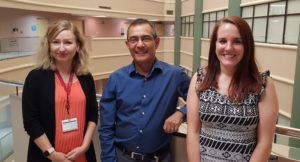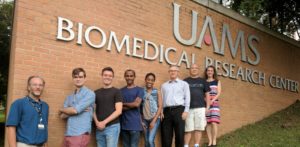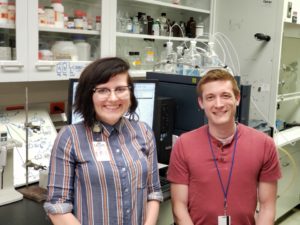Congratulations to Dr. Isabelle Racine-Miousse who received a pilot grant from the Barton Foundation for her studies of methionine and autophagy in metastatic melanoma.
UAMS Researcher Joins International Colleagues in Urging Open Access to Genomics Data
Scientific discovery could be accelerated with more open access to genomic data, says an article in the latest journal Science by a group of research leaders from across the globe that includes David W. Ussery, Ph.D., at the University of Arkansas for Medical Sciences (UAMS).
“We argue that the publicly available data should be treated as open data, a shared resource with unrestricted use for analysis, interpretation and publication,” the article states in the journal’s Policy Forum titled, “Toward unrestricted use of public genomic data.”
The article, with 51 authors, challenges long-standing customs and guidelines that have allowed the producers of genomics data to keep it for analysis and publication before outside researchers can study it.
As a specialist in bacterial genomics, Ussery, a professor in the UAMS College of Medicine Department of Biomedical Informatics, said a better understanding of genome sequences will help scientists more easily determine where outbreaks originate and how they can be treated.
“In my field, it is critical to have unrestricted access to this kind of genomic data,” said Ussery, a member of the international Genomics Standards Consortium. “Some of our biggest scientific advances are likely to come from genomics research, and we need to remove barriers that could delay discoveries.”
The article calls for revising the landmark 2003 Fort Lauderdale Agreement, which is a public declaration by scientists supporting free and unrestricted use of genome sequencing data. The agreement, the authors say, is “self-contradictory” because it also recommends a hands-off approach to publicly available data so that those who produced the data have a chance to analyze and publish it.
A key factor in the article’s push is the growing wave of raw data from faster, inexpensive third-generation genome sequencing devices, said Ussery, who holds the Helen Adams & Arkansas Research Alliance Endowed Chair in Bioinformatics.
“By 2025, the amount of data from third-generation sequencing will dwarf other big data generators like Youtube and Twitter,” Ussery said. “Youtube is expected to reach 2 exabytes, but third-generation sequencing will produce about 20 zettabytes of data.” A zettabyte is 1,000 times larger than an exabyte.
In a recent presentation, Ussery cited the 20 zettabyte projection for genetic sequencing data, noting that the estimated cost to store that much data is $2 trillion.
In fact, with the advent of large global data analysis studies, the article says, the amount of publicly available data is at the scale of yottabytes (1,000 times larger than a zettabyte).
Scientific analysis of so much data requires costly computing resources and advanced analytical capabilities, and some scientists who produce genomic data don’t have those advanced capabilities. In those cases, outside researchers should be allowed free access to the data without restriction.
“For example,” the article states, “the outsider team may have better analytical capabilities and/or overarching protocols for analyzing more comprehensive sets of data, pre- or post-publication. Also, sequence datasets can be interrogated by means of numerous value-added platforms and tools from multiple groups.”
The article cites three guiding principles for their recommendations:
- Public genomics data that have ethics approval for release should be open data – available for unrestricted use, together with associated metadata – with the exception of sensitive human data to which additional ethics restrictions may apply
- Science advances through open competition with clear-cut, transparent rules, not through posing restrictions and limitations
- Credit should be given appropriately to resource producers (those who produce the data) and should be transparent.
“These recommendations should not impede protection of sensitive human data,” the article states. “We acknowledge that for existing sensitive human data, some restrictions may be appropriate.”
The article is available here: http://science.sciencemag.org/content/363/6425/350.
December publications from the Biochemistry department
Delgado M, Urbaniak A, Chambers TC.
Biochem Pharmacol.
Marecki JC, Aarattuthodiyil S, Byrd AK, Penthala NR, Crooks PA, Raney KD.
Bioorg Med Chem Lett.
 NIH dollars go to too few US states.
NIH dollars go to too few US states.
Wahls WP.
Nature.
Boysen G, Jamshidi-Parsian A, Davis MA, Siegel ER, Kore RA, Dings RPM, Griffin RJ.
Int J Radiat Biol.
Dr. Diekman praised for teaching
Medical students praised Dr. Alan Diekman for his teaching efforts during a recent breakfast with Dean Westfall. Congratulations Dr. Diekman!
November publications
Byrum SD, Loughran AJ, Beenken KE, Orr LM, Storey AJ, Mackintosh SG, Edmondson RD, Tackett AJ, Smeltzer MS.
Journal of Proteome Research
Kriss CL, Gregory-Lott E, Storey AJ, Tackett AJ, Wahls WP, Stevens SM Jr.
Alcohol Clin Exp Res
Pouncey DL, Hartman JH, Moore PC, Dillinger DJ, Dickerson KW, Sappington DR, Smith ES 3rd, Boysen G, Miller GP.
Blood Coagul Fibrinolysis
Wilson CD, Tai S, Ewing L, Crane J, Lockhart T, Yarbrough AL, Fujiwara R, Radominska-Pandya A, Fantegrossi WE.
J Pharmacol Exp Ther
An G, Schmidt RL, Mock DM, Veng-Pedersen P, Widness JA.
AAPS Journal
Pif1 helicase unfolding of G-quadruplex DNA is highly dependent on sequence and reaction conditions.
Byrd AK, Bell MR, Raney KD.
Journal of Biological Chemistry
Human Breast-Milk Feeding Enhances the Humoral and Cell-Mediated Immune Response in Neonatal Piglets
Miklavcic JJ, Badger TM, Bowlin AK, Matazel KS, Cleves MA, LeRoith T, Saraf MK, Chintapalli SV, Piccolo BD, Shankar K, Yeruva L.
Journal of Nutrition
Cancer Institute Member Spotlight
Samantha Kendrick, Ph.D.
Assistant Professor, Department of Biochemistry and Molecular Biochemistry and
Department of Pathology (secondary appointment)
UAMS College of Medicine
Research Interest Statement
Non-Hodgkin’s lymphoma has the ninth highest incidence rate in Arkansas, with diffuse large B-cell lymphoma (DLBCL) as the most commonly diagnosed subtype. Current treatment fails to achieve long-term disease-free survival in about 40 percent of DLBCL patients, either as upfront resistance to first-line therapy or following relapse after successful initial treatment. Our laboratory is dedicated to understanding the mechanisms behind aggressive forms of this malignancy and discovering new therapeutic strategies to improve patient outcome. In order to address this important area of cancer research, we integrate basic and translational science by utilizing ex vivo, cell line and tumor tissue-based models, paired with genomic and proteomic approaches. Ongoing projects include teasing out why certain oncogenes are susceptible to genomic instability, how DNA secondary structures may play a role in this process and can serve as novel targets for therapy, the impact of HIV infection on the development of lymphoma, and the differences between lymphoma that develops in children compared to adults.
Grants
UAMS Foundation Fund Board
Medical Research Endowment Award
Exploring DNA secondary structures as new therapeutic targets for aggressive lymphoma
1/1/2019 – 12/31/2019
$15,000*
Winthrop P. Rockefeller Cancer Institute Foundation Envoys
Seeds of Science Award
Identifying DNA sequence motifs critical for mutations in diffuse large B-cell lymphoma
2/15/2018 – 2/14/2019
$10,000*
* cancer-related annual direct costs
Dr. Kendrick’s UAMS Collaborators
Brendan Frett, Ph.D. (Pharmaceutical Sciences)
Stephanie Byrum, Ph.D. (Director of Bioinformatics Core, Arkansas Children’s Research Institute)
Timothy Chambers, Ph.D. (Biochemistry and Molecular Biology)
Ginell Post, M.D. (Pathology)
Dr. Kendrick’s External Collaborators
David Schatz, Ph.D. (Yale University; Howard Hughes Medical Institute)
Elizabeth Connick, M.D. (University of Arizona)
Amy Chadburn, M.D. (Cornell University)
Christian Stiedl, Ph.D. (University of British Columbia; British Columbia Cancer Agency)
Shankar Balasubramanian, Ph.D. (Cambridge University)
David Tannahill, Ph.D. (Cambridge University)
Opportunities for Collaboration
I welcome collaborations with basic and physician scientists, hematology oncologists, pathology fellows and residents, and bioinformaticians interested in joining forces to combat aggressive lymphoma and reduce the mortality of lymphoma patients.
You Might Not Know That
I am originally from the Great White North, and similar to my fellow Canadians, I enjoy maple syrup, hockey and bundling up next to the fire to read a good book.
Cancer-Related Publications
Kendrick S, Muranyi A, Gokhale V, Hurley LH, Rimsza LM. Simultaneous drug targeting of the promoter MYC G-quadruplex and BCL2 i-motif in diffuse large B-cell lymphoma slows tumor growth. J Med Chem 2017; 60:6587-97.
Kendrick S, Rimsza LM, Scott DW, et al. Aberrant cytoplasmic expression of MHCII confers worse progression free survival in diffuse large B-cell lymphoma. Virchows Arch 2017; 470:113-117.
Kendrick S, Tus K, Wright G, et al. Diffuse large B-cell lymphoma cell-of-origin classification using the Lymph2Cx assay in the context of BCL2 and MYC expression status. Leuk Lymphoma 2016; 57:717-20.
Li L, Pongtornpipat P, Tiutan T, Kendrick SL, et al. Synergistic induction of apoptosis in high-risk DLBCL by BCL2 inhibition with ABT-199 combined with pharmacologic loss of MCL1. Leukemia 2015; 29:1702-12.
Alan Tackett named ABI Established Investigator of the year
Alan Tackett, Ph.D., Professor of Biochemistry and Scharlu Family Endowed Chair in Cancer Research, was named as the Arkansas Biosciences Institute Established Investigator of the Year for his work on histone epigenetic mechanisms that regulate gene transcription and that are coupled to melanoma progression. He is also the director of the Center for Translational Pediatric Research and the IDeA National Resource for Proteomics. Congratulations Dr. Tackett!
Regional ACS meeting in Little Rock
Shout-out to Dr. Grover Miller, Professor of Biochemistry and Molecular Biology, for his vision, creativity and hard work in planning “the Natural State of Chemistry,” the 74th Southwest Regional Meeting of the American Chemical Society (ACS). The meeting was held in Little Rock Nov. 7-12 with a comprehensive technical program highlighting the collaborative and creative nature of chemical research in the region. Dr. Miller chaired the first regional session of the ACS Division of Chemical Toxicology.
Members of the Miller and Raney labs also presented at the meeting.
Allie Davis presented a poster entitled “Bioactivation of halogen-containing drugs as precursors to drug-induced hepatotoxicity”.
Dusty Barnette presented a poster entitled “Lamisil (terbinafine) bioactivation involves multiple cytochromes P450 based on computation and experimental approaches”.
Dakota Pouncey presented a poster entitled “Hydroxywarfarins Efficiently Reduced to Alcohols by the Human Liver Cytosol”.
Andrea Edwards presented a poster entitled “G-Quadruplex in PARP1-Mediated DNA Damage Response”.
Binyam Belachew presented a poster entitled “Function and Mechanism of Hepatitis C Virus Non-structural Protein 3 (HCV NS3) Unfolding of Viral G-quadruplex RNA Structures”.
UAMS Researchers Receive $1.8 Million to Study Common Mechanisms Shared by Alzheimer’s, Other Diseases
Nov. 15, 2018 | A team of University of Arkansas for Medical Sciences (UAMS) research scientists recently was awarded a $1.8 million, five-year grant by the National Institute on Aging to investigate common pathways that contribute to the aging of various tissues.
Robert Shmookler Reis, D. Phil, professor in the UAMS College of Medicine’s Donald W. Reynolds Department of Geriatrics, and Srinivas Ayyadevara, associate professor in same department, are the co-principal investigators leading the study. Co-investigators are Steve Barger, Ph.D., professor in the Departments of Geriatrics and Neurobiology & Developmental Sciences, and Alan Tackett, professor in the Department of Biochemistry & Molecular Biology.
The goal of the research is to identify what different neurodegenerative diseases like Alzheimer’s disease have in common with other age-progressive diseases and conditions such as heart disease, muscle wasting, kidney disease, and type 2 diabetes.
Protein aggregation — clustering or clumping of protein molecules — has long been recognized as a hallmark of neurodegenerative diseases like Alzheimer’s and Parkinson’s.
“We were the first ones to show that protein aggregation happens not just in the brain, but also in the heart, skeletal muscle and kidney with age and age-associated diseases,” Ayyadevara said. Reis added, “The misfolding of proteins, which contributes to protein aggregation, is promoted by stress and inflammation, accumulating with age.”
Reis said the team has looked at protein aggregation for nearly a decade, funded by grants from the U.S. Department of Veteran Affairs. For the last two years, it has also been supported as part of a multi-investigator National Institutes of Health (NIH) grant led by Sue Griffin, Ph.D., professor and vice chair of research at the UAMS Donald W. Reynolds Institute on Aging. Peter Crooks, Ph.D., D.Sc., chair and professor of the Department of Pharmaceutical Sciences in the UAMS College of Pharmacy, developed novel derivatives of anti-inflammatory drugs.
As part of the NIH grant, Crooks, Reis, Ayyadevara, and graduate student Samuel Kakraba tested these drugs for their ability to inhibit protein aggregation and to extend life. One drug, PNR502, was the main subject of a recently awarded patent covering several bioactive compounds.
“It not only inhibits further protein aggregation but even appears to reverse it,” Ayyadevara said. “Working with Dr. Barger, we will examine whether it can preserve youthful functions in the hearts and brains of normal mice, and in a mouse model of Alzheimer’s.”
“We have shown that protein aggregation accompanies aging of all tissues, and probably contributes causally to most or all age-associated diseases,” said Reis. “This fundamental molecular process may underlie most of the deterioration that defines aging. It’s a Pandora’s box that holds all the things that go wrong as we get older, so it offers an unprecedented opportunity to finally understand how and why so many disparate factors contribute to aging.”
Oleg Karaduta was invited to give an oral talk at Global Summit on Proteomics
Oleg Karaduta from Boris Zybaylov’s lab was invited to give an oral talk at the Second Global Summit and EXPO on Proteomics in Dallas, TX. His presentation highlighted the basics of metaproteomics data processing pipe-line, its application to the study of function of gut microbiome in chronic kidney disease and current results of their research.



